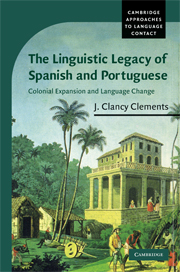Book contents
- Frontmatter
- Contents
- List of figures
- List of maps
- List of tables
- Series editor's foreword
- Acknowledgements
- List of abbreviations and acronyms
- 1 Language contact, language learning, and language change
- 2 The general socio-historical context of Portuguese and Castilian
- 3 Portuguese- and Spanish-lexified creole languages
- 4 Bozal Spanish of Cuba
- 5 Chinese Coolie Spanish in nineteenth-century Cuba
- 6 Chinese Immigrant Spanish
- 7 Andean Spanish
- 8 Barranquenho
- 9 Contact, cognition, and speech community
- Appendix A
- Appendix B
- Bibliography
- Author index
- General index
3 - Portuguese- and Spanish-lexified creole languages
Published online by Cambridge University Press: 30 September 2009
- Frontmatter
- Contents
- List of figures
- List of maps
- List of tables
- Series editor's foreword
- Acknowledgements
- List of abbreviations and acronyms
- 1 Language contact, language learning, and language change
- 2 The general socio-historical context of Portuguese and Castilian
- 3 Portuguese- and Spanish-lexified creole languages
- 4 Bozal Spanish of Cuba
- 5 Chinese Coolie Spanish in nineteenth-century Cuba
- 6 Chinese Immigrant Spanish
- 7 Andean Spanish
- 8 Barranquenho
- 9 Contact, cognition, and speech community
- Appendix A
- Appendix B
- Bibliography
- Author index
- General index
Summary
Introduction
Portugal's linguistic legacy in the world was essentially established by 1550, about 135 years after Portugal began its maritime expansion to Africa, Asia, and the Americas. Varieties of Portuguese or derived from Portuguese are not only spoken as official languages in a number of nations (Portugal, Brazil, Cape Verde, Angola, Mozambique), but also found in numerous communities from West Africa to India, to Malaysia, and Macau. Rather than attempting to survey all the Portuguese- and Spanish-lexified creole languages, I have chosen to examine two phenomena in this chapter: affixal tense–aspect markers (TMAs) and grammatical/semantic relation markers (G/SRMs). These two groups of markers were chosen in order to illustrate two fundamentally different outcomes in contact-induced language change, as well as to examine the extent to which universal processes were involved in the formation of these creoles.
To be able to talk about the emergence of the tense–aspect markers in the creole languages under consideration, I give in section 3.2 a brief overview of the external ecology of fifteenth- and sixteenth-century Portugal, the socio-historical background which led to the formation of restructured varieties of Portuguese that constituted one of the bases of pidgin Portuguese. In section 3.3, I focus on the presence of affixal tense–aspect markers, the presence of which in some of the creoles is most revealingly understood, I argue, within the backdrop of the demographic make-up of Portugal during that time. In section 3.4, I examine the anomalies in the case-marking systems of Portuguese- and Spanish-based creoles: as noted by Croft (1991) – who shows that natural languages avoid certain syncretisms – there are violations of a fairly strong typological tendency.
- Type
- Chapter
- Information
- The Linguistic Legacy of Spanish and PortugueseColonial Expansion and Language Change, pp. 42 - 67Publisher: Cambridge University PressPrint publication year: 2009



